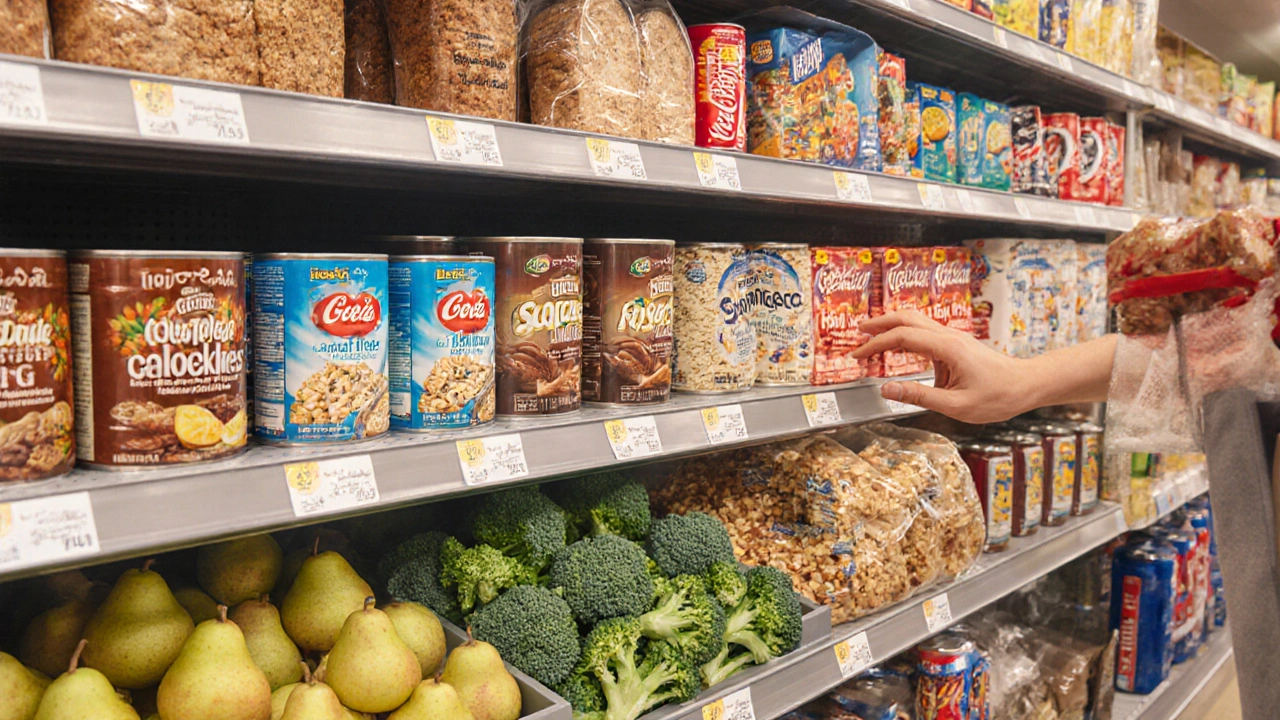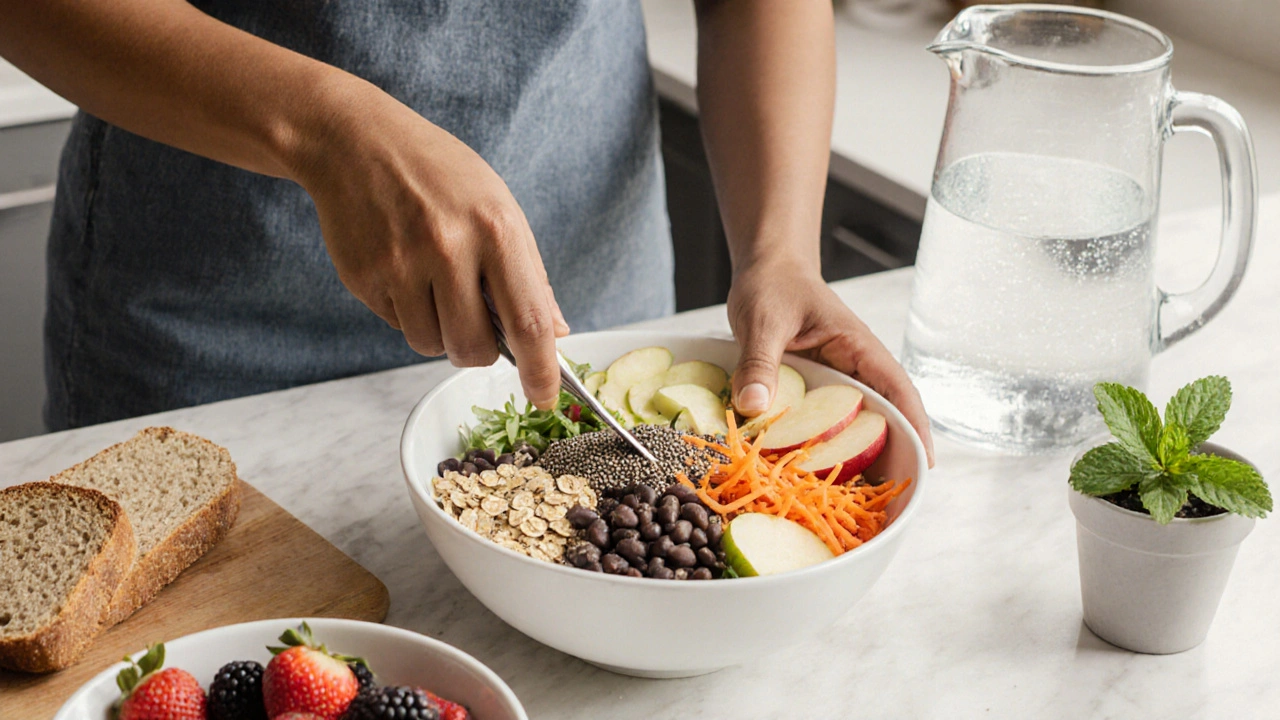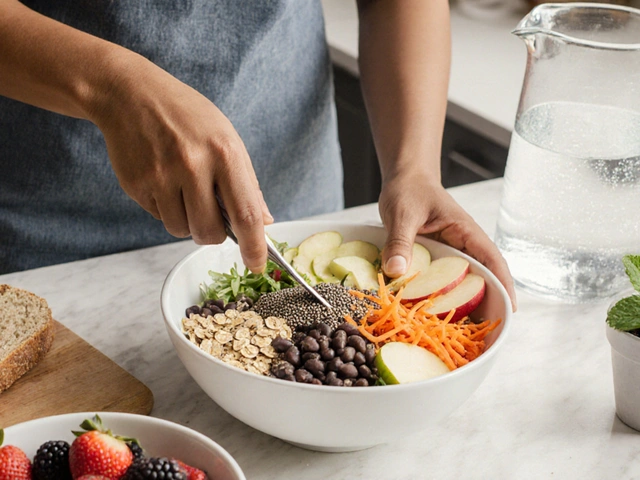Fiber Intake Tracker for Chronic Diarrhea
Add Food Entry
Daily Fiber Summary
Soluble Fiber Total: 0 g
Insoluble Fiber Total: 0 g
Total Fiber: 0 g
Current Entries
| Food | Type | Amount (g) |
|---|
Recommendations
Enter food entries to get personalized recommendations based on your fiber intake.
Fiber is a plant‑based carbohydrate that your body can’t digest, but that plays a crucial role in gut health. For people battling chronic diarrhea, the right kind of fiber can turn a chaotic digestive system into something more predictable. This guide breaks down why fiber matters, which types help calm loose stools, and exactly what to put on your plate - and what to leave out.
How Fiber Works in the Digestive Tract
When you eat fiber, it travels through the stomach untouched and reaches the colon where bacteria ferment it. The fermentation process produces short‑chain fatty acids that help seal the gut lining and slow water loss. At the same time, fiber adds bulk, which signals the colon to contract in a more orderly rhythm. Both actions can reduce the frequency and urgency of diarrheal episodes.
Not all fiber behaves the same way. The two main families - soluble fiber and insoluble fiber - have opposite effects on water. Soluble fiber dissolves in water, forming a gel that absorbs excess fluid. Insoluble fiber stays coarse, pulling water into the stool and speeding passage.
Soluble vs. Insoluble Fiber: Which One Helps Diarrhea?
Because chronic diarrhea is essentially a problem of too much water in the stool, soluble fiber is usually the star player. It thickens the intestinal contents, helping the body reclaim water before it reaches the rectum. Insoluble fiber can be useful in low‑moderate amounts to add structure, but too much can actually worsen loose stools.
| Aspect | Soluble Fiber | Insoluble Fiber |
|---|---|---|
| Water interaction | Forms gel, absorbs water | Retains water, adds bulk |
| Typical sources | Oats, beans, apples, psyllium | Whole wheat, nuts, vegetables peel |
| Effect on stool | Thickens, slows transit | Accelerates transit, may loosen stool |
| Best for chronic diarrhea | Yes (moderate doses) | Limited; use sparingly |
What to Eat: Fiber‑Rich Foods That Calm the Gut
Below are the top picks that deliver soluble fiber without overwhelming the system. Aim for 5-10g of soluble fiber per day, spread across meals.
- Psyllium husk - a single tablespoon provides ~5g of gel‑forming fiber. Mix it into water, smoothies, or oatmeal.
- Cooked oat bran or rolled oats - ½ cup cooked oats yields ~2g soluble fiber and is gentle on the stomach.
- Ripe bananas - the pectin in bananas acts like a natural thickener; a medium banana adds about 1g soluble fiber.
- Cooked carrots and sweet potatoes - the cooking process breaks down pectin, making it more soluble. One cup supplies ~2g.
- Applesauce (unsweetened) - apples contain pectin; a half‑cup provides ~1g soluble fiber without the crunch that can irritate a sensitive gut.
Pair these foods with a probiotic‑rich source such as plain yogurt or kefir. A healthy gut microbiome works hand‑in‑hand with fiber to ferment it efficiently.

What to Avoid: Fiber Foods That Can Worsen Diarrhea
Some high‑fiber foods are packed with insoluble fiber or other components that draw water into the colon.
- Whole‑grain breads with large seed mixes - the seeds contribute insoluble fiber that may accelerate stool.
- Raw cruciferous veggies (broccoli, cauliflower) - tough cellulose can be hard to break down and may cause gas.
- Legume soups that aren’t pureed - beans are high in both soluble and insoluble fiber; the insoluble part can be problematic in excess.
- High‑fructose fruits (mango, pineapple) - fructose can act as an osmotic laxative, pulling water into the gut.
- Artificial sweeteners such as sorbitol - not a fiber, but they mimic its water‑binding effect and can trigger loose stools.
When you’re in a flare‑up, stick to low‑fiber, low‑residue options like white rice, plain potatoes, or toast while you re‑introduce soluble fiber slowly.
Building a Daily Meal Plan
- Breakfast: A bowl of oatmeal made with water, topped with a sliced banana and a teaspoon of psyllium husk. Add a dollop of plain yogurt for probiotic support.
- Mid‑morning snack: A small cup of applesauce or a peeled, cooked apple.
- Lunch: Grilled chicken or tofu, a serving of steamed carrots, and a side of white rice. Sprinkle a tablespoon of oat bran into the rice for extra soluble fiber.
- Afternoon snack: A smoothie with kefir, a handful of soft berries, and half a teaspoon of psyllium.
- Dinner: Baked salmon, mashed sweet potato, and a small portion of zucchini (peeled and cooked). Finish with a cup of herbal tea that contains no caffeine.
Track your fiber intake using a simple spreadsheet - note the source, type (soluble vs. insoluble), and grams. If you notice a sudden increase in stool frequency, reduce the amount by 25% and give your gut a few days to adjust.
Common Pitfalls & Pro Tips
Pitfall 1: Adding too much fiber at once. Your gut bacteria need time to adapt. Increase slowly, about 2-3g per day.
Pitfall 2: Skipping fluids. Soluble fiber pulls water into the gut; without enough liquid, it can cause constipation or cramping. Aim for at least 2L of water daily.
Pitfall 3: Ignoring the role of fat. Healthy fats (olive oil, avocado) can slow gastric emptying, giving fiber more time to act.
Pro tip: Use a low‑dose fiber supplement (e.g., 2g psyllium) on days when meals are bland. This keeps the gut “trained” without overloading.
Remember, every body reacts differently. If symptoms persist beyond two weeks despite dietary changes, it’s wise to consult a gastroenterologist - chronic diarrhea can signal underlying conditions like IBS‑D, inflammatory bowel disease, or microscopic colitis.
All this information shows how strategic use of fiber and chronic diarrhea management can restore comfort and confidence in daily life.
Frequently Asked Questions
Can insoluble fiber ever help with diarrhea?
In small amounts, insoluble fiber can add structure to the stool, but large doses usually pull more water into the colon, worsening diarrhea. If you need bulk, stick to a 1‑2g serving per day and pair it with plenty of soluble fiber.
How quickly does psyllium start working?
Most people notice a change within 12‑24hours, as the husk forms a gel that slows transit. Consistency is key; take it with at least 8oz of water each time.
Is it safe to use fiber supplements long‑term?
Yes, for most adults, as long as you stay hydrated and rotate between different fiber sources to keep the gut microbiome diverse. People with bowel obstruction should avoid high‑dose supplements.
Should I avoid all fruit during a diarrhea flare?
Not all fruit. Low‑FODMAP, low‑fructose options like ripe bananas or canned peaches (in water) are usually safe. High‑fructose fruits can draw extra water and should be limited.
Can I combine fiber changes with probiotic foods?
Absolutely. Probiotics help the bacteria that ferment soluble fiber, boosting the production of short‑chain fatty acids that seal the gut lining. A daily serving of yogurt, kefir, or fermented vegetables works well.









Comments (10)
Jessica Martins
September 29, 2025 AT 04:14 AMI appreciate the thoroughness of this guide; it clearly distinguishes soluble and insoluble fiber. The explanation of how soluble fiber forms a gel is especially useful for readers dealing with chronic diarrhea. Including a practical daily tracker is a nice touch for self‑monitoring. Just a reminder to increase fiber intake gradually to avoid sudden bloating. Overall, the article balances scientific detail with actionable advice.
Doug Farley
October 6, 2025 AT 08:28 AMOh great, another fiber fan club post-just what my diarrhea needed.
Jeremy Olson
October 13, 2025 AT 12:41 PMFiber, as a non‑digestible carbohydrate, plays a pivotal role in modulating colonic water balance and stool consistency. When soluble fiber reaches the large intestine, it absorbs water and forms a viscous gel, thereby reducing luminal fluid loss. This gel also provides a substrate for saccharolytic bacteria, which produce short‑chain fatty acids that reinforce the mucosal barrier. Conversely, insoluble fiber retains water within the stool matrix, accelerating transit and potentially exacerbating diarrheal output. The guide correctly emphasizes that moderate soluble fiber intake, ranging from five to ten grams daily, can ameliorate chronic diarrhea without inducing constipation. It is essential to note that abrupt increases in fiber can overwhelm the resident microbiota, leading to excessive gas production and abdominal discomfort. Therefore, a stepwise increment of two to three grams per day is advisable for most patients. Hydration status must be monitored closely, as soluble fiber’s water‑binding capacity can increase the demand for fluid intake. The recommendation to consume at least two liters of water daily aligns with this physiological need. Moreover, pairing fiber with probiotic‑rich foods such as yogurt or kefir can enhance microbial fermentation efficiency, fostering a healthier colonic environment. The table contrasting soluble and insoluble fiber provides a clear visual aid that aids quick reference. It is noteworthy that while insoluble fiber can add bulk, its overconsumption may counteract the benefits of soluble fiber in diarrheal states. The inclusion of a simple interactive tracker empowers users to log their intake and observe trends over time. This self‑monitoring approach aligns with evidence‑based dietary counseling strategies. Finally, the article prudently advises seeking medical evaluation if symptoms persist beyond two weeks, acknowledging that chronic diarrhea may signal underlying pathologies such as IBS‑D or inflammatory bowel disease.
Calvin Smith
October 20, 2025 AT 16:54 PMWow, Jessica, you sound like you’re reading a textbook – nice and proper. But let’s get real: nonstop oat bran can turn your bathroom trips into a marathon. If you think sprinkling psyllium on toast will save you, think again – it needs a decent glass of water or you’ll just be constipated. And those “gradual increments” are a joke; most people just want relief now, not a semester‑long experiment. So yeah, the guide is solid, but the real world is messier.
Brenda Hampton
October 27, 2025 AT 21:08 PMThis guide hits all the right notes! I love the clear split between soluble and insoluble fibers – it makes planning meals so much easier. The sample meal plan looks both tasty and practical, especially the banana‑psyllium combo. I’ll definitely start tracking my intake with the provided tool. Thanks for making a complicated topic feel approachable.
Lara A.
November 4, 2025 AT 01:21 AMWow!!! Another "expert" post pushing mainstream nutrition. Have you considered that the so‑called "fiber" industry is secretly funded by big agribusiness??!!! They want us to eat more processed oat “brans” while they hide the truth about hidden sugars and additives!!! Stay vigilant, read the fine print, and don’t trust anything that tells you to “just drink water”!!
Ashishkumar Jain
November 11, 2025 AT 05:34 AMHey folks, this is a great step forward! I love how the article breaks down the types of fiberr and gives real food ideas. Definately try to add a spoonful of psyllium to your smoothie – its a game changer. Its also super important to keep a water bottle handy; solubl fiber needs that liquid to work right. Keep experimenting and you’ll find what works best for your gut!
Gayatri Potdar
November 18, 2025 AT 09:48 AMAlright, so you think just eating bananas and oat bran will fix everything? Wake up! The pharma companies are pushing this “natural cure” narrative so they can later sell you pricey probiotic pills. And don’t even start with the “avoid high‑fructose fruits” line – they’re just trying to control your grocery list. Trust your own gut instincts before you swallow another diet tip.
Marcella Kennedy
November 25, 2025 AT 14:01 PMWhat a comprehensive resource! It’s not often you see a guide that blends scientific explanation with practical day‑to‑day tips so seamlessly. I especially appreciate the emphasis on gradual fiber introduction; many people jump in too fast and end up with more discomfort. The interactive tracker is a clever way to keep yourself accountable, and the recommendation to pair fiber with probiotic foods really rounds out the approach. Remember, each person’s tolerance can differ, so listening to your body remains key. Also, staying hydrated cannot be overstated – the water‑fiber balance is essential for optimal results. Finally, seeking professional advice if symptoms linger is sound advice; we shouldn’t ignore potential underlying issues.
Poonam Mali
December 2, 2025 AT 18:14 PMThe article’s level of detail is impressive, but let’s discuss the jargon for a moment. While “short‑chain fatty acids” sound scientific, the average reader might just need to know it helps seal the gut lining. Moreover, the phrase “microbial fermentation efficiency” could be simplified to “good bacteria working better.” These nuances matter for accessibility. Still, the evidence‑backed recommendations deserve kudos. A sprinkle of plain language would make this guide even more user‑friendly.